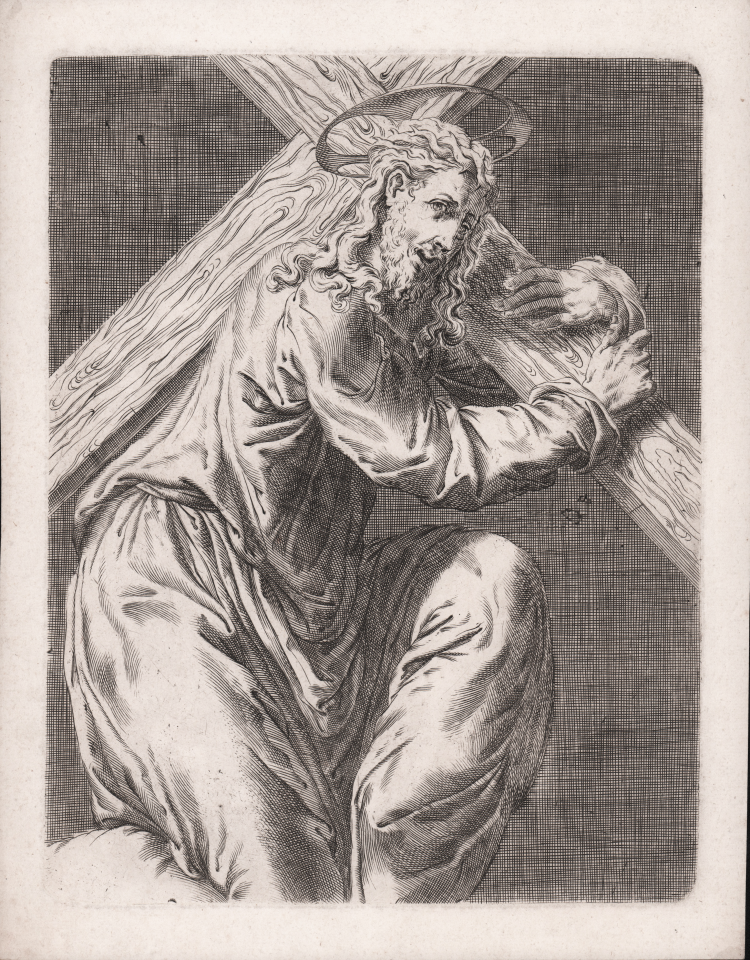




| Reference: | S21429 |
| Author | Domenico PIOLA |
| Year: | 1590 ca. |
| Measures: | 215 x 280 mm |



| Reference: | S21429 |
| Author | Domenico PIOLA |
| Year: | 1590 ca. |
| Measures: | 215 x 280 mm |
Ascribed to Domeico Piola.
Engraving, end of the XVI century, signed with “DP” monogram on centre plate.
Beautiful work, printed on contemporary laid paper with “lily in the circle with bird" watermark, with full margins, in perfect condition.
This magnificent Italian Mannerist engraving has never been listed in any catalogue.
From a stylistic point of view, it can be ascribed to Orazio de Sanctis, an artist who basically realized copies after Pompeo Cesura’s subjects, also known as Aquilano, and also to Domenico Piola. The signature "DP" leads us to attribute this work to the Genoese artist.
Not listed by literature.
|
Non descritta nei repertori.
|
Domenico PIOLA (Attivo intorno alla metà del XVII sec.)
|
Domenico Piola was taught to paint by his brother, Pellegro Piola (1617–40). He later worked in partnership with his younger brother, Giovanni Andrea Piola (1627–c. 1713); his three sons Paolo Gerolamo Piola, Anton Maria Piola (1654–1715) and Giovanni Battista Piola (d 1725); his two sons-in-law, Gregorio de’ Ferrari and Domenico Parodi; and his brother-in-law Stefano Camogli, a specialist in arabesques of flowers and fruit. From the time of Luca Cambiaso, Genoese ceilings had consisted of rich decorative frescoes surrounded by elaborate ornament. From the latter half of the 17th century and into the early 18th century the Casa Piola came to dominate and unify the production of the various elements involved: quadratura, stucco, sculpture and painting. The workshop’s eminence in all these media enabled it to achieve an artistic monopoly that partially accounts for the decorative consistency in Genoa in the last half of the century. Large decorative projects were comprehensively prepared through drawings, progressing from careful studies of details through compositional sketches to full-scale cartoons. In their decorative projects featuring illusionistic effects the Casa Piola also designed the quadratura, which, to judge from drawings, was often as important to them as the central section of the vault. They also regarded sculpture as an integral part of the design and supplied designs for sculptors, among them Filippo Parodi, Antonio Maria Maragliano, Bernardo Schiaffino and Francesco Maria Schiaffino. Drawings for altars, tabernacles, ship ornaments, clocks, ceramics and metalwork indicate that the workshop also supplied ideas for craftsmen to elaborate. Paolo Gerolamo succeeded his father as head of the workshop and the studio ended with the death of Giovanni Battista Piola, Piola’s great grandson, in 1768. (b Genoa, 1627; d Genoa, 8 April 1703). Painter, draughtsman, printmaker and designer. He was the leading artist in Genoa in the second half of the 17th century, providing ceiling frescoes for many Genoese churches and palaces and producing paintings for private collectors. He was also a prolific draughtsman, whose many designs for thesis pages and book illustrations promoted his work throughout Europe. The enormous and multifarious productivity of his studio, his numerous collaborations with other artists and the fact that most of his most ambitious projects have been destroyed have discouraged any systematic study of his work.
|
|
Non descritta nei repertori.
|
Domenico PIOLA (Attivo intorno alla metà del XVII sec.)
|
Domenico Piola was taught to paint by his brother, Pellegro Piola (1617–40). He later worked in partnership with his younger brother, Giovanni Andrea Piola (1627–c. 1713); his three sons Paolo Gerolamo Piola, Anton Maria Piola (1654–1715) and Giovanni Battista Piola (d 1725); his two sons-in-law, Gregorio de’ Ferrari and Domenico Parodi; and his brother-in-law Stefano Camogli, a specialist in arabesques of flowers and fruit. From the time of Luca Cambiaso, Genoese ceilings had consisted of rich decorative frescoes surrounded by elaborate ornament. From the latter half of the 17th century and into the early 18th century the Casa Piola came to dominate and unify the production of the various elements involved: quadratura, stucco, sculpture and painting. The workshop’s eminence in all these media enabled it to achieve an artistic monopoly that partially accounts for the decorative consistency in Genoa in the last half of the century. Large decorative projects were comprehensively prepared through drawings, progressing from careful studies of details through compositional sketches to full-scale cartoons. In their decorative projects featuring illusionistic effects the Casa Piola also designed the quadratura, which, to judge from drawings, was often as important to them as the central section of the vault. They also regarded sculpture as an integral part of the design and supplied designs for sculptors, among them Filippo Parodi, Antonio Maria Maragliano, Bernardo Schiaffino and Francesco Maria Schiaffino. Drawings for altars, tabernacles, ship ornaments, clocks, ceramics and metalwork indicate that the workshop also supplied ideas for craftsmen to elaborate. Paolo Gerolamo succeeded his father as head of the workshop and the studio ended with the death of Giovanni Battista Piola, Piola’s great grandson, in 1768. (b Genoa, 1627; d Genoa, 8 April 1703). Painter, draughtsman, printmaker and designer. He was the leading artist in Genoa in the second half of the 17th century, providing ceiling frescoes for many Genoese churches and palaces and producing paintings for private collectors. He was also a prolific draughtsman, whose many designs for thesis pages and book illustrations promoted his work throughout Europe. The enormous and multifarious productivity of his studio, his numerous collaborations with other artists and the fact that most of his most ambitious projects have been destroyed have discouraged any systematic study of his work.
|